By Bob Difley
 In answer to my question in one of my boondocking classes on why only a small percentage of RVers boondock regularly, one woman responded that she could not give up her electric blanket. A gruff oldtimer said he was a growling bear if he didn’t get his cup of coffee when he woke up.
In answer to my question in one of my boondocking classes on why only a small percentage of RVers boondock regularly, one woman responded that she could not give up her electric blanket. A gruff oldtimer said he was a growling bear if he didn’t get his cup of coffee when he woke up.
How perceptions can differ from one person to another on what is necessary to boondock. The electric blanket was something I didn’t even own. And wouldn’t throwing another blanket on the bed solve that deterrent? And substitute a Melita drip type coffee maker or French press for the plug-in coffee pot and you have your coffee.
In reality, it is most likely not a technical item that is required to enjoy boondocking, but a perceived convenience item–the electric blanket–designed to keep one warm but required continuous 120-volt electrical current over an eight-hour period, something that a non-energy-requiring extra blanket or quilt would accomplish just as well.
Or requiring 110-volt electricity to heat your coffee water when a propane gas stove–which nearly all RVs have built in–works just as well if not better. So when you begin setting up your rig for boondocking, it may be just as important to consider exactly what will make you comfortable and enhance your boondocking experience rather than just filling up your cart with boondocking “must have” items at the local RV parts store.
Spend just as much time on how to achieve personal warmth, comfort, cleanliness, healthy meals, and enjoyment of the great outdoors as you do on whether the inverters, solar panels, generators, tank capacities, battery capacities, and amps + volts + watts will accomplish those desires, and whether all that stuff is really worth the expense compared to, well, just throwing on another blanket.
With my wife and I, our boondocking trips are based on fresh water more than any other factor. We are physically active, exercising–running, hiking, kayaking, bicycling–enough to raise a good sweat everyday. Having the capacity to shower every day was far more important than an electric blanket or an ice maker or air-conditioning or power to run a big screen TV.
So we learned how to take Navy showers and conserve water use in other areas. We carried extra Jerry jugs of water to dump in our tank and kept the empties in our dinghy so we could fill them when we went to town for supplies. This was a much easier solution than either cutting back (horrors) on our physical activity or feeling uncomfortable and smelly in our own dried sweat.
Everybody is different and has different needs and wants. So when you are considering boondocking–or expanding the extent of your boondocking trips–take the little things that are important to your RV lifestyle just as seriously as what kind of gadgets and equipment you “need.” The end result will likely be that the most important equipment will be those that accomplish the level of comfort and enjoyment they bring.
For more RVing articles and tips take a look at my Healthy RV Lifestyle website, where you will also find my ebooks: BOONDOCKING: Finding the Perfect Campsite on America’s Public Lands (PDF or Kindle), 111 Ways to Get the Biggest Bang for your RV Lifestyle Buck (PDF or Kindle), and Snowbird Guide to Boondocking in the Southwestern Deserts (PDF or Kindle), and my newest, The RV Lifestyle: Reflections of Life on the Road (Kindle reader version). NOTE: Use the Kindle version to read on iPad and iPhone or any device that has the free Kindle reader app.


